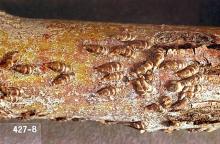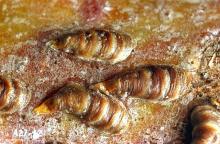Lepidosaphes ulmi
Pest description and damage Scale insects are small (less than 0.125 inch in length) soft insects that live beneath waxy scales. These insects are often identified by the shape and size of their scales, the description of adult males and females, immature crawler stage, color of eggs, and host plant preferences. The mature oystershell scale is approximately 0.13 inch in length, with a brownish, or gray scale that is usually elongated and slightly curved like an oyster or mussel shell. Oystershell scales are found on trunks, branches, and twigs of many broad-leaved deciduous plants. They occur less frequently on the leaves and other plant parts like fruit and seed pods. Scale infestations often are initially limited to isolated colonies on single branches or twigs. Newly emerged crawlers look like minute, bright white pimples on the bark.
Biology and life history The oystershell scale overwinters as the egg stage beneath the scale and do not hatch until early summer. The new crawlers are white and only crawl about for a few hours before settling in place and beginning to build the shell. Initially, the scale cover is a loose lattice of white wax that remains vulnerable to any pesticide applications until late summer when it forms a more solid scale covering. Once the solid scale is completely formed, they are less vulnerable to pesticides, but still vulnerable to predators and parasitoids.
Pest monitoring Use doublesided sticky tape to trap crawlers or inspect around infestations for the bright white crawlers in mid to late June. New scales have a fresh pinkish look to them, while old dead scales become gray. Since the waxy scales remain after insects have died, it is important to sample the patches of scales to determine if this is a live infestation, or if the scales were controlled by natural enemies.
Management-cultural control
For small infestations, scrape away the scales with fingernail or stiff brush. Hang a bird feeder in the tree to attract insectivorous birds to the area.
Management-biological control
Parasitoid wasps and predatory mites feed on life stages of the oystershell scale. There is a definite reduction in the number of eggs produced when predatory mites are present. Other predators include lady beetles and birds such as chickadees, nuthatches and brown creepers. Search for smooth round holes (parasitoid exit holes), ragged holes (beetle predation) in each scale, or white areas where the scales have been removed (bird predation) to determine the level of natural enemies and surviving scale abundance.
Management-chemical control
See Table 1 in:
Chemical Control of Landscape Pests
For more information
See "Scale insect" in:


